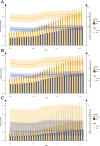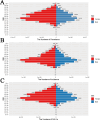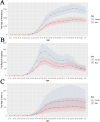Burden of knee osteoarthritis in China and globally: 1990-2045
- PMID: 40598022
- PMCID: PMC12219446
- DOI: 10.1186/s12891-025-08858-8
Burden of knee osteoarthritis in China and globally: 1990-2045
Abstract
Background: Knee osteoarthritis (KOA) is a major global health challenge, with rising prevalence, incidence, and disability-adjusted life years (DALYs). This disease increasingly burdens healthcare systems worldwide, particularly as populations age and obesity rates rise. In China, the rapid demographic shift towards an aging population, combined with rising obesity rates, makes KOA a pressing public health issue. China is projected to experience a significant increase in the number of elderly individuals, who are particularly vulnerable to KOA. Additionally, gender disparities, with women being more affected, add further urgency. Addressing KOA in China requires targeted healthcare strategies, considering these unique demographic and lifestyle factors.
Methods: We utilized data from the Global Burden of Disease (GBD) 2021 database to assess the prevalence, incidence, and DALYs related to KOA both globally and in China. The decomposition analysis was used to evaluate the contributions of population aging, growth, and epidemiological changes. For prediction, we employed the Bayesian Age-Period-Cohort (BAPC) model, implemented using the Integrated Nested Laplace Approximation (INLA) method, to project future trends from 2022 to 2045.
Results: From 1990 to 2021, both China and globally experienced significant increases in the burden of KOA. In China, the age-standardized prevalence rate (ASPR) increased from 4,667.29 (95% UI: 3,996.06-5,359.85) per 100,000 in 1990 to 5,016.52 (95% UI: 4,265.22-5,758.38) per 100,000 in 2021. Globally, the ASPR rose from 3,964.75 (95% UI: 3,411.86-4,536.4) per 100,000 in 1990 to 4,294.27 (95% UI: 3,695.04-4,910.76) per 100,000 in 2021. Similarly, the age-standardized incidence rate (ASIR) in China increased from 377.93 (95% UI: 324.79-434.28) per 100,000 in 1990 to 406.42 (95% UI: 348.7-467.23) per 100,000 in 2021, compared to a global increase from 330.26 (95% UI: 284.34-375.75) to 353.67 (95% UI: 304.56-402.5). The age-standardized DALY rate (ASDR) in China rose from 151.24 (95% UI: 72.96-291.47) per 100,000 in 1990 to 162.44 (95% UI: 78.35-314.13) per 100,000 in 2021, whereas the global ASDR rose from 127.14 (95% UI: 62.17-246.99) per 100,000 in 1990 to 137.59 (95% UI: 67.08-266.87) per 100,000 in 2021. The prevalence, incidence, and DALYs of KOA were consistently higher in females compared to males. In both regions, population growth had the most significant impact on KOA burden, but population aging was a more significant factor in China. High BMI and metabolic risk factors, particularly in females, were identified as key contributors to KOA-related DALYs. This study projects the trends in knee osteoarthritis (KOA) burden in China and globally by 2045. In China, the Age-Standardized Prevalence Rate (ASPR) is projected to increase by approximately 2.5% (from 5016.52 to 5142.90), while the Age-Standardized Incidence Rate (ASIR) is expected to decrease by about 8.8% (from 406.43 to 370.72). Globally, the ASPR is expected to rise by around 7.8% (from 4294.26 to 4630.97), while the ASIR is projected to increase by 5.8% (from 353.67 to 374.13). The Age-Standardized Death Rate (ASDR) is expected to increase in both China (by 1.3%, from 162.44 to 164.61) and globally (by 5.7%, from 137.59 to 145.45). These projections suggest an overall rise in the burden of KOA, with regional variations.
Conclusion: KOA remains a significant and increasingly complex global health challenge, with its burden expected to rise sharply in the coming decades. This study highlights that in both China and globally, the escalating prevalence of KOA is closely linked to population aging and obesity, but the drivers vary across regions. In China, the rising burden is predominantly influenced by demographic aging, making it critical to develop targeted interventions that address the needs of an aging population. Globally, the expansion of the population is the primary contributor to the increased KOA burden, which underscores the importance of integrating KOA prevention into broader public health strategies aimed at managing population growth and associated lifestyle risks. The findings underscore the urgency of addressing obesity as a key risk factor for KOA, especially in women. Public health interventions should focus on obesity prevention, particularly in middle-aged and older populations, and include strategies such as promoting healthier diets, physical activity, and metabolic health management. Furthermore, policies aimed at improving joint health in aging populations, with a focus on early diagnosis and rehabilitation, could significantly alleviate the long-term societal and healthcare costs associated with KOA.
Keywords: Decomposition analysis; Disability-adjusted life years; Global burden; Knee osteoarthritis; Metabolic risk factors; Obesity; Population aging; Prediction analysis.
© 2025. The Author(s).
Conflict of interest statement
Declarations. Ethics approval and consent to participate: This study is based on publicly available, de-identified data obtained from the GBD Study 2021, conducted by the Institute for Health Metrics and Evaluation (IHME). Ethical approval for the GBD study was obtained by IHME from the University of Washington Institutional Review Board. Ethical approval for this secondary analysis was not required, as it involved only publicly available data in accordance with local legislation and institutional requirements. Written informed consent was not required from the participants or their legal guardians/next of kin, as the data were anonymized and aggregated prior to access. Consent for publication: Consent for publication is not applicable. Competing interests: The authors declare no competing interests.
Figures









Similar articles
-
The global burden of fractures and its underlying etiologies: results from and further analysis of the Global Burden of Disease Study 2021.Arch Osteoporos. 2025 Aug 6;20(1):111. doi: 10.1007/s11657-025-01596-3. Arch Osteoporos. 2025. PMID: 40764873
-
The global impact of non-alcoholic fatty liver disease (including cirrhosis) in the elderly from 1990 to 2021 and future projections of disease burden.PLoS One. 2025 Jun 25;20(6):e0325961. doi: 10.1371/journal.pone.0325961. eCollection 2025. PLoS One. 2025. PMID: 40560868 Free PMC article.
-
[Disease burden and future trend predictions of age-related hearing loss in China and worldwide from 1990 to 2021].Beijing Da Xue Xue Bao Yi Xue Ban. 2025 Jun 18;57(3):545-553. doi: 10.19723/j.issn.1671-167X.2025.03.019. Beijing Da Xue Xue Bao Yi Xue Ban. 2025. PMID: 40509833 Free PMC article. Chinese.
-
National and subnational burden of brain and central nervous system cancers in China and global from 1990 to 2021: results from the global burden of disease study 2021.Arch Public Health. 2025 Jul 28;83(1):195. doi: 10.1186/s13690-025-01683-4. Arch Public Health. 2025. PMID: 40722045 Free PMC article.
-
A rapid and systematic review of the clinical effectiveness and cost-effectiveness of paclitaxel, docetaxel, gemcitabine and vinorelbine in non-small-cell lung cancer.Health Technol Assess. 2001;5(32):1-195. doi: 10.3310/hta5320. Health Technol Assess. 2001. PMID: 12065068
Cited by
-
Global, regional, and national burden of colorectal cancer in the elderly (aged > 60 years): a comprehensive analysis across 204 countries and territories (1990-2021).BMC Gastroenterol. 2025 Aug 9;25(1):570. doi: 10.1186/s12876-025-04184-4. BMC Gastroenterol. 2025. PMID: 40783503 Free PMC article.
References
-
- Berenbaum F. Osteoarthritis as an inflammatory disease (osteoarthritis is not osteoarthrosis!). Osteoarthritis Cartilage. 2013;21(1):16–21. - PubMed
-
- Lu Y, Xiao W, Tao K: Global burden of osteoarthritis attributable to high body mass index, 1990–2021: insights from the Global Burden of Disease study 2021. Arthritis Rheumatol 2025. - PubMed
MeSH terms
LinkOut - more resources
Full Text Sources
Medical

